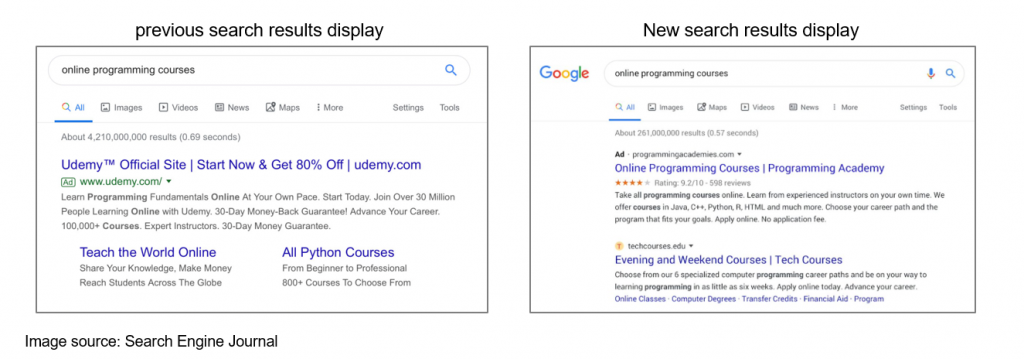24th January 2020
POV: Google Desktop Search Results Redesign
Background:
Google has rolled out changes to the way that search results are displayed on desktop. These changes were launched on mobile in May last year but are now visible on desktop search results.
Details and Implications:
It’s a well-known fact that Google often tweaks and changes how the paid and organic results look on a SERP, as part of an ongoing test and learn program. However, the latest change rolled out could possibly be described as the most radical change yet, and a departure from the usual direction of making paid ads as prominent and attractive as possible.
Search ads used to be marked with an ‘Ad’ label in green, inside a green box, next to the URL, also in green. They are now marked by a small, grey/black bolded ‘Ad’ next to the URL, which is also grey/black. The position has also been changed, with the ‘Ad’ label and URL previously under the headline text, whereas now it is found above the headline text.
Organic search results have also changed, a ‘favicon’ (a small logo / icon) has been added - it sits where the ‘Ad’ label sits for paid results. Crucially, it’s clear that Paid and Organic results are becoming more difficult to distinguish by the non-trained eye.

Initial reaction has not been entirely favourable, with many industry watchers pointing out that ads are now harder to identify. This, however, seems to be precisely the point. According to Google, the design is intended to present ‘domain names and brand icons prominently’ to put branding ‘front and center, helping you better understand where the information is coming from’. The new design was launched for mobile in 2019 but has been spotted on desktop over the last week and Google announced the desktop roll out on Twitter on the 13th January.
Site owners can define a brand logo as the ‘favicon’ to be shown in search results but it must follow particular guidelines to qualify. This will give marketers another element to consider when optimising sites for organic search. Whether it will affect CTRs and site rankings without ‘favicons’ is unclear. Based on early data it appears that CTRs on ads have already increased, according to a report in Digiday. This could be due to consumers finding it harder to tell the difference between paid and organic results now that the favicon and ad icons are a similar size.
Summary:
It seems that Google has shifted direction on how Paid and Organic results are shown on a results page. Whilst these changes have sparked a reaction amongst marketers and consumers, only time will tell whether it really affects CTRs and website traffic for many advertisers and brands. We will be keeping an eye on our Paid and Organic performance results related to this change; and advising clients accordingly.
Further reading: Digiday | TechCrunch | Google | Search Engine Journal | Search Engine Land |